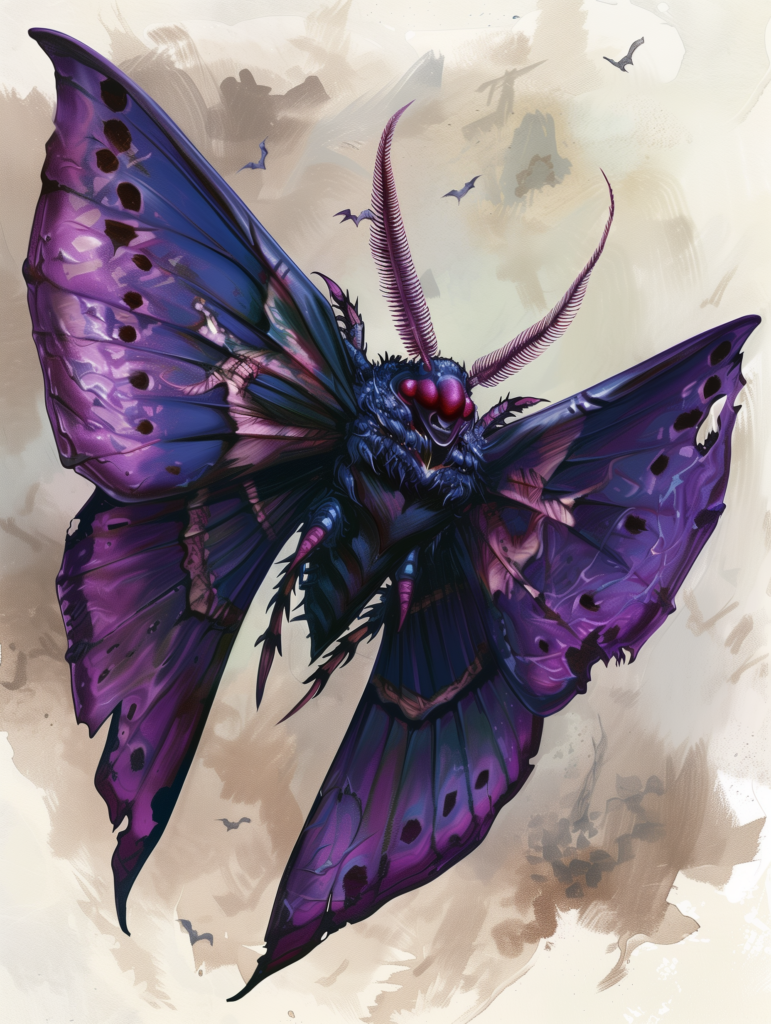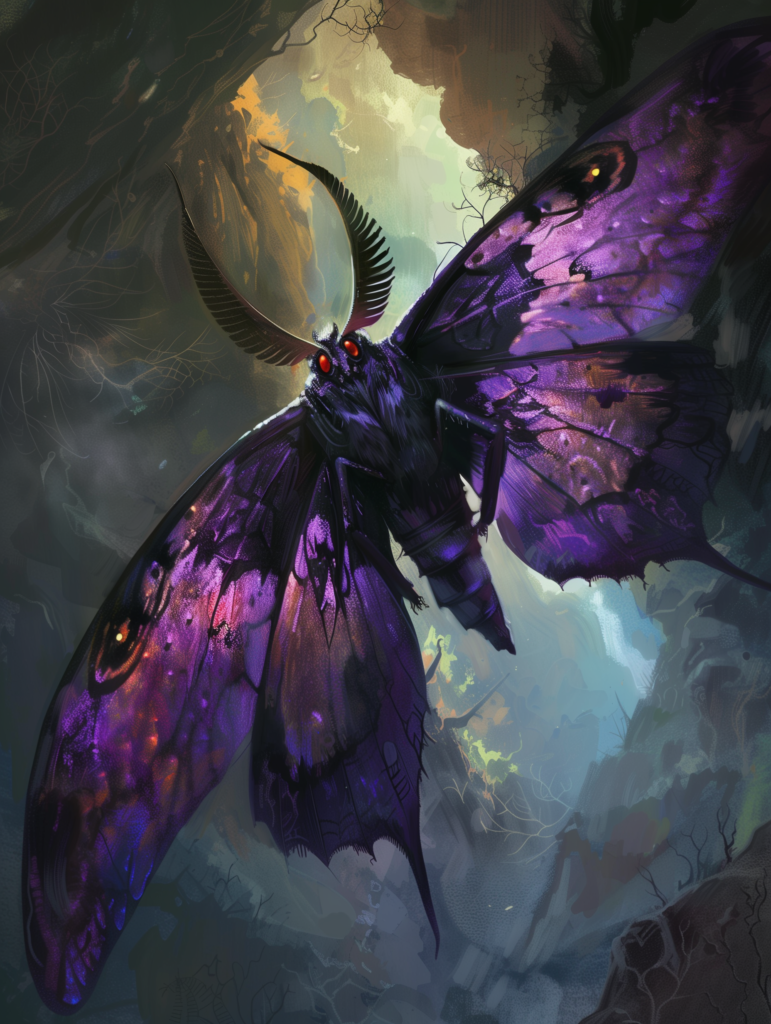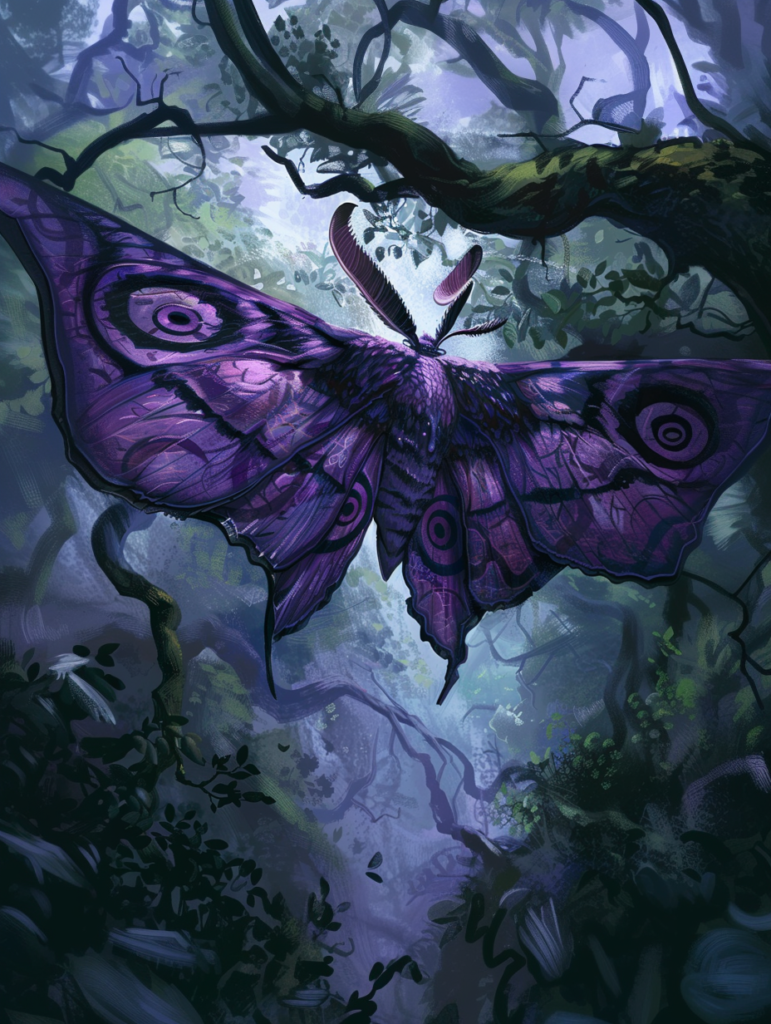Gloomwing
“Beware the Shadows: Meet the Gloomwing, Harbinger of Tenebrous Terror!”

Appearance: Gloomwings are eerie creatures resembling oversized moths, with wings spanning several feet and covered in a dark, shadowy membrane. Their bodies are slender and elongated, with jet-black exoskeletons that absorb light, making them appear as if they’re part of the darkness itself. Glowing, crimson eyes pierce through the gloom, unsettling those who dare to meet their gaze.
Behavior: Despite their insectoid appearance, Gloomwings possess a crude intelligence, operating on primal instincts for survival and propagation. They are nocturnal creatures, active during dawn and dusk, preferring to hide in shadowy areas during daylight hours. Gloomwings are solitary hunters, seeking out prey to implant their eggs into, perpetuating their species through a gruesome cycle of parasitism.
Habitat: Gloomwings originate from the Plane of Shadow, but occasionally find themselves on the Material Plane through rifts between dimensions. They gravitate towards places of deep shadow, such as abandoned buildings, caves, or dense foliage, where they can blend seamlessly into the darkness and await their next victim.
Modus Operandi: Gloomwings are opportunistic predators, using their stealth and agility to ambush unsuspecting prey. They swoop down from the shadows, attacking with their razor-sharp mandibles and injecting their victims with eggs that hatch into tenebrous worms. These larvae feed on the host’s flesh until they mature into fully grown Gloomwings, continuing the cycle of predation.
Motivation: The primary motivation of Gloomwings is to propagate their species by implanting their eggs into living hosts. This drive compels them to hunt relentlessly, seeking out suitable victims to serve as hosts for their offspring. Though they do not possess higher cognitive functions, their instinctual desire to reproduce fuels their actions, making them persistent and dangerous adversaries.
Gloomwing 5e
Gloomwing Pathfinder
Gloomwing

Large monstrosity, neutral
Armor Class 12
Hit Points 75 (10d10+20)
Speed 10 ft., fly 40 ft.
| STR | DEX | CON | INT | WIS | CHA |
|---|---|---|---|---|---|
| 14 (+2) | 15 (+2) | 14 (+2) | 2 (-5) | 12 (+1) | 10 (+0) |
Skills Perception +3, Stealth +4
Senses darkvision 60 ft., passive Perception 13
Languages –
Challenge 2 (450 XP)
- Implant. As an action, a gloomwing can lay eggs inside a Small or larger helpless or dead creature. A creature implanted with gloomwing eggs must make a DC 12 Constitution save each morning; on a failure, the creature takes 10 (3d6) necrotic damage and its maximum Hit Points is decreased by the same amount. A creature whose maximum Hit Points are reduced to 0 or below dies. Within 24 hours of a creature’s death from this damage, 1d4 young tenebrous worms emerge from the corpse, devouring it completely in the process. The eggs can be destroyed via any effect that cures disease.
- Pheromones (Recharge After a Short or Long Rest). As a bonus action, the gloomwing can activate its pheromones. At the beginning of its next turn, it emits a strange, musky scent in a 30-foot radius. All creatures within this area (except for other gloomwings or tenebrous worms) must make a DC 12 Constitution saving throw at the beginning of each of the gloomwing’s turns to avoid becoming weakened by the pheromones. A creature that fails it saving throw has disadvantage on Strength checks, Strength saving throws, and attack rolls based on Strength for 1 hour. Creatures that are immune to being poisoned are unaffected.
ACTIONS
- Multiattack. It uses Hypnotic Wings. Then it attacks with a bite and claws.
- Bite. Melee Weapon Attack: +4 to hit, reach 5 ft., one target. Hit: 6 (1d8 + 2) piercing damage.
- Claws. Melee Weapon Attack: +4 to hit, reach 5 ft., one target. Hit: 9 (2d6 + 2) slashing damage.
- Hypnotic Wings. The eerie shifting of patterns on a gloomwing’s wings is hypnotic. Any creature within 30 feet that does not avert its gaze from the gloomwing must make a DC 12 Wisdom save or become confused for 1 round. Gloomwings and tenebrous worms are immune to this effect. An affected target can’t take reactions and must roll a d10 at the start of each of its turns to determine its behavior for that turn.
| d10 | Behavior |
|---|---|
| 1 | The creature uses all its movement to move in a random direction. To determine the direction, roll a d8 and assign a direction to each die face. The creature doesn’t take an action this turn. |
| 2-6 | The creature doesn’t move or take actions this turn. |
| 7-8 | The creature uses its action to make a melee attack against a randomly determined creature within its reach. If there is no creature within its reach, the creature does nothing this turn. |
| 9-10 | The creature can act and move normally. |
Gloomwings are strange, moth-like natives of the Plane of Shadow. Despite their appearance, they are not vermin and possess a crude but serviceable intelligence.
Some are conjured via magic to serve as guardians or even mounts, and occasionally a gloomwing will slip through a tear in the fabric of the planes and make the journey to the Material Plane on its own.
A gloomwing loose on the Material Plane is active for 2 to 3 hours at dawn and again for 2 to 3 hours at dusk, preferring to spend the remaining hours of the day hiding in abandoned buildings, caves, or deep canyons or foliage where the shadows are thickest. During its periods of activity, it flies through the sky on the hunt for creatures to attack and implant its eggs in—the gloomwing does not need to eat, leaving this urge to propagate its species as its primary drive.
Lethal Larvae. For all the dangers a gloomwing presents, it is the creature’s young that pose the gravest threat. These creatures are known as tenebrous worms, and despite being the larval form of the adult gloomwing, are much more dangerous creatures.
The fact that a gloomwing can lay several eggs a day if presented with enough living hosts makes them dangerous not for what they can inflict themselves, but for what they can spawn.
Section 15: Copyright Notice
Faerie Bestiary (5E) © 2022, Legendary Games; Authors Matt Kimmel, Michael “solomani” Mifsud, Miguel Colon, Robert J. Grady, Jason Nelson, Jeff Ibach, Tim Hitchcock.

This immense moth has huge purple wings marked with spiraling black patterns that seem to shift and writhe.
Gloomwing CR 4
XP 1,200
N Large outsider (extraplanar)
Init +3; Senses darkvision 60 ft.; Perception +8
DEFENSE
AC 19, touch 12, flat-footed 16 (+3 Dex, +7 natural, –1 size)
hp 37 (5d10+10)
Fort +3, Ref +7, Will +5
OFFENSE
Speed 10 ft., fly 40 ft. (good)
Melee bite +6 (1d8+2), 2 claws +6 (1d6+2)
Space 10 ft.; Reach 5 ft.
Special Attacks confusion, implant, pheromones
STATISTICS
Str 15, Dex 17, Con 15, Int 2, Wis 12, Cha 10
Base Atk +5; CMB +8; CMD 21
Feats Ability Focus (confusion), Flyby Attack, Hover
Skills Fly +5, Perception +9, Stealth +7 (+11 in dim light); Racial Modifiers +4 Stealth in dim light
SPECIAL ABILITIES
Confusion (Su)
The eerie shifting of patterns on a gloomwing’s wings is hypnotic—any creature within 30 feet that does not avert its gaze from the gloomwing must make a DC 14 Will save at the start of each turn or become confused for 1 round. This is a mind-affecting effect—gloomwings and tenebrous worms are immune to this effect. The save DC is Charisma-based.
Implant (Ex)
A gloomwing can lay eggs inside a Small or larger helpless or dead creature as a full-round action that provokes attacks of opportunity. A creature implanted with gloomwing eggs must make a DC 14 Fortitude save each morning to avoid suffering 1d4 points of Constitution damage. Within 24 hours of a creature’s death from this damage, 1d4 young tenebrous worms emerge from the corpse, devouring it completely in the process. The eggs can be destroyed via any effect that cures disease, but the eggs themselves are not treated as a disease for purposes of what creatures are immune to this effect. The save DC is Constitution-based.
Pheromones (Su)
After the first round of combat, a gloomwing can emit a strange, musky scent in a 30-foot radius as a free action. All creatures within this area (save for other gloomwings or tenebrous worms) must make a DC 14 Fortitude save each round to avoid becoming weakened by the pheromones. Once a creature fails a save against this effect, it takes a –4 penalty to its Strength score—this penalty lasts for as long as the battle continues and for 1 hour thereafter. Lesser restoration or any other effect capable of healing ability damage immediately removes this Strength penalty. The save DC is Constitution-based.
ECOLOGY
Environment any (Plane of Shadow)
Organization solitary
Treasure none
Gloomwings are strange, moth-like natives of the Plane of Shadow. Despite their appearance, they are not vermin and possess a crude but serviceable intelligence. While gloomwings can be conjured via spells like lesser planar ally or lesser planar binding to serve as guardians or even mounts, occasionally a gloomwing will slip through a tear in the fabric of the planes and make the journey to the Material Plane on its own.
A gloomwing loose on the Material Plane is active for 2 to 3 hours at dawn and again for 2 to 3 hours at dusk, preferring to spend the remaining hours of the day hiding in abandoned buildings, caves, or deep canyons or foliage where the shadows are thickest. During its periods of activity, it flies through the sky on the hunt for creatures to attack and implant its eggs in—the gloomwing does not need to eat, leaving this urge to propagate its species as its primary drive.
For all the dangers a gloomwing presents, it is the creature’s young that pose the gravest threat. These creatures are known as tenebrous worms, and despite being the larval form of the adult gloomwing, are much more dangerous creatures. The fact that a gloomwing can lay several eggs a day if presented with enough living hosts makes them dangerous not for what they can inflict themselves, but for what they can spawn.
Section 15: Copyright Notice
Pathfinder Roleplaying Game Bestiary 2, © 2010, Paizo Publishing, LLC; Authors Wolfgang Baur, Jason Bulmahn, Adam Daigle, Graeme Davis, Crystal Frasier, Joshua J. Frost, Tim Hitchcock, Brandon Hodge, James Jacobs, Steve Kenson, Hal MacLean, Martin Mason, Rob McCreary, Erik Mona, Jason Nelson, Patrick Renie, Sean K Reynolds, F. Wesley Schneider, Owen K.C. Stephens, James L. Sutter, Russ Taylor, and Greg A. Vaughan, based on material by Jonathan Tweet, Monte Cook, and Skip Williams.

 Buy me a coffee
Buy me a coffee